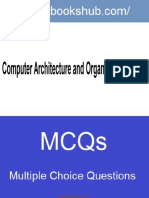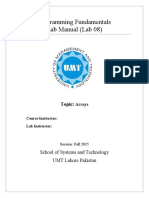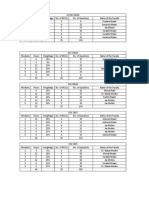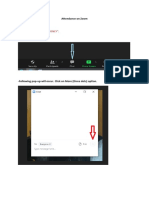Dce Sem 5 Syllabus
Dce Sem 5 Syllabus
Uploaded by
Jay MehtaCopyright:
Available Formats
Dce Sem 5 Syllabus
Dce Sem 5 Syllabus
Uploaded by
Jay MehtaOriginal Title
Copyright
Available Formats
Share this document
Did you find this document useful?
Is this content inappropriate?
Copyright:
Available Formats
Dce Sem 5 Syllabus
Dce Sem 5 Syllabus
Uploaded by
Jay MehtaCopyright:
Available Formats
Subject Subject Teaching Scheme Credits Assigned
Code Name (Hrs.)
Theory Practical Tutorial Theory Practical Tutorial Total
ECCDLO Data 04 -- -- 04 -- -- 04
5014 Compression
& Encryption
Examination Scheme
Theory Marks
Subject Subject
Name Internal assessment Term Practical Oral
Code Work & Oral Total
Avg. Of Test End Sem.
Test 1 Test2 1 and Test 2 Exam
ECCDLO Data 20 20 20 80 -- -- -- 100
5014 Compression
& Encryption
Course objectives:
To teach the students
Lossless and Lossy compression techniques for different types of data.
Data Encryption Techniques.
Network and Web Security.
Course outcomes:
After successful completion of the course student will be able to
Implement text, audio and video compression techniques.
Understand Symmetric and Asymmetric Key Cryptography schemes.
Understand network security.
University of Mumbai, B. E. (Electronics & Telecommunication Engineering), Rev 2016 33
Module Unit Topics Hrs.
No. No.
1.0 Introduction to Data Compression 12
1.1 Data Compression : Modelling and Coding, Statstical Modelling,
Dictionary Schemes, LZ, Lossy Compression
1.2 Shannon – Fano Algorithm, Huffman Algorithm, Adaptive Huffman
Coding
1.3 Difficulties in Huffman Coding, Arithmetic Coding – Decoding,
Dictionary Based Compression, Sliding Window Compression: LZ-
77, LZ-78, LZW
2.0 Image Compression 06
2.1 DCT, JPEG, JPEG – LS, Differential Lossless Compression,
DPCM, JPEG – 2000 Standards
3.0 Video and Audio Compression 08
3.1 Analog Video, Digital Video, MPEG – 2, H – 261 Encoder and
Decoder
3.2 Sound, Digital Audio, μ-Law and A-Law Companding, MPEG – 1
Audio Layer (MP3 Audio Format)
4.0 Data Security 06
4.1 Security Goals, Cryptographic Attacks, Techniques
4.2 Symmetric Key: Substitution Cipher, Transposition Cipher , Stream
and Block Cipher
4.3 DES, AES
5.0 Number Theory and Asymmetric Key Cryptography 08
5.1 Prime Numbers, Fermat's and Euler's Theorem, Chinese Remainder
Theorem, Discreet Logarithms
5.2 Principles of Public Key Crypto System, RSA
5.3 Key Management, Deffie-Hellman Key Exchange
5.4 Message Integrity, Message Authentication and Hash Functions,
SHA, H MAC, Digital Signature Standards
6.0 Network Security 08
6.1 Email, PGP, S/MIME, Intrusion Detection System
6.2 Web Security Considerations, SSL Architecture, SSL Message
Formats, TLS, Secure Electronic Transactions
6.3 Kerberos, X.509 Authentication Service, Public Key Infrastructure
Total 48
University of Mumbai, B. E. (Electronics & Telecommunication Engineering), Rev 2016 34
Text Books:
1. Mark Nelson, Jean-Loup Gailly,”The Data Compression Book”, 2nd edition, BPB
Publications
2. Khalid Sayood, ”Introduction to Data Compression”, 2nd Edition Morgan Kaufmann.
3. William Stallings, “Cryptography and Network Security Principles and Practices 5 th
Edition”, Pearson Education.
4. Behrouz A. Forouzan, “Cryptography and Network Security”, Tata McGraw-Hill.
Reference Books:
1. David Salomon, “Data Compression: The Complete Reference”, Springer.
2. Matt Bishop, “Computer Security Art and Science”, Addison-Wesley.
Internal Assessment:
Assessment consists of two class tests of 20 marks each. The first class test is to be conducted
when approximately 40% syllabus is completed and second class test when additional 40%
syllabus is completed. The average marks of both the test will be considered for final Internal
Assessment. Duration of each test shall be of one hour.
End Semester Examination:
1. Question paper will comprise of 6 questions, each carrying 20 marks.
2. The students need to solve total 4 questions.
3. Question No.1 will be compulsory and based on entire syllabus.
4. Remaining question (Q.2 to Q.6) will be selected from all the modules.
Note: Term Work should be based on Tutorials.
University of Mumbai, B. E. (Electronics & Telecommunication Engineering), Rev 2016 35
You might also like
- CorrectDocument3 pagesCorrectJay MehtaNo ratings yet
- Practical File: Internet Programming LabDocument26 pagesPractical File: Internet Programming Labmohd ameerNo ratings yet
- Shannon and 5 Criteria of A Good CipherDocument10 pagesShannon and 5 Criteria of A Good CipherSina ManaviNo ratings yet
- CS 391L Machine Learning Course SyllabusDocument2 pagesCS 391L Machine Learning Course SyllabusOm SinghNo ratings yet
- Bca NotesDocument8 pagesBca NotesDivya SharmaNo ratings yet
- Final ReportDocument8 pagesFinal ReportMD. ABIR HASAN 1704018No ratings yet
- HSST Computer ScienceDocument4 pagesHSST Computer ScienceHenna tkNo ratings yet
- ML Lab ManualDocument66 pagesML Lab ManualAmareNo ratings yet
- 12.2.1 Resolution Principle (1) : - Resolution Refutation Proves A Theorem byDocument31 pages12.2.1 Resolution Principle (1) : - Resolution Refutation Proves A Theorem bySaurav techNo ratings yet
- Cyber Forensics Unit 3 Upto MidtermDocument14 pagesCyber Forensics Unit 3 Upto MidtermJawaNo ratings yet
- C - Program To Store Details of An Employee in A Structure - Stack OverflowDocument3 pagesC - Program To Store Details of An Employee in A Structure - Stack OverflowSachin PuriNo ratings yet
- Solution of End-Of-Semester Assessment Sample Paper (Kathy)Document14 pagesSolution of End-Of-Semester Assessment Sample Paper (Kathy)tom lamNo ratings yet
- Symmetric Cipher": A) Passive AttackDocument24 pagesSymmetric Cipher": A) Passive AttackSalman ShaikhNo ratings yet
- CSE - 5th Semester NotesDocument5 pagesCSE - 5th Semester NotesShubham ChoudharyNo ratings yet
- Ip Security (Ipsec)Document18 pagesIp Security (Ipsec)gdayanand4uNo ratings yet
- Dsf-Pyt-Lab ManualDocument50 pagesDsf-Pyt-Lab Manualthilakraj.a0321No ratings yet
- Computer Networking MCQDocument8 pagesComputer Networking MCQMunab Ashique AlamNo ratings yet
- SPPM Total MaterialDocument115 pagesSPPM Total Materialsai tejaNo ratings yet
- ML Lab Manual (1-10) FINALDocument34 pagesML Lab Manual (1-10) FINALchintuNo ratings yet
- Cyber Check Manual Version 3.0Document316 pagesCyber Check Manual Version 3.0Sudip MaityNo ratings yet
- Digital Forensics: Unit No. 1 Computer ForensicsDocument2 pagesDigital Forensics: Unit No. 1 Computer ForensicskingraajaNo ratings yet
- 9d25206a Secure Software EngineeringDocument1 page9d25206a Secure Software EngineeringcomputerstudentNo ratings yet
- Programming With Python - PGDBDA - Feb20Document26 pagesProgramming With Python - PGDBDA - Feb20AKSHAY WADITKENo ratings yet
- Lab Manual Daa Ad3351 Aids III Sem Regulation 2021Document48 pagesLab Manual Daa Ad3351 Aids III Sem Regulation 2021adhi1437adhiNo ratings yet
- Ug-r20-Eee & Ece MPMC SyllabusDocument3 pagesUg-r20-Eee & Ece MPMC SyllabusSanoxNo ratings yet
- Write A Java Program To Implement The DES Algorithm LogicDocument6 pagesWrite A Java Program To Implement The DES Algorithm Logicpradeepthi gajulaNo ratings yet
- Advance Data Structures Notes-R23Document107 pagesAdvance Data Structures Notes-R23manikantagrandhi240eeNo ratings yet
- OS 2 MarksDocument15 pagesOS 2 Marksapi-3693857100% (11)
- Apollo Institute of Engineering and Technology: Question Bank Branch: IT Subject: Artificial Intelligence (3161608)Document2 pagesApollo Institute of Engineering and Technology: Question Bank Branch: IT Subject: Artificial Intelligence (3161608)Cricket top HitsNo ratings yet
- Lab Assignment OOPSDocument64 pagesLab Assignment OOPSShreya SharmaNo ratings yet
- DeltaX - Fresher Sample App - SpotifyDocument5 pagesDeltaX - Fresher Sample App - SpotifyGaurav Joshi (RA1811005020035)No ratings yet
- "Dynamic Password Policy Generation System: A Project Report OnDocument76 pages"Dynamic Password Policy Generation System: A Project Report OnSharonNo ratings yet
- COMSATS University Islamabad, Wah Campus: Final (Fall 2020)Document3 pagesCOMSATS University Islamabad, Wah Campus: Final (Fall 2020)nm100% (1)
- We Can Mathematically Express A Single MD5 Operation As FollowsDocument5 pagesWe Can Mathematically Express A Single MD5 Operation As FollowstbijleNo ratings yet
- Cs3461-Os Lab - 2021 RDocument3 pagesCs3461-Os Lab - 2021 RArunsunai ComputerNo ratings yet
- Chapter 11 Cryptographic Hash FunctionsDocument38 pagesChapter 11 Cryptographic Hash FunctionsNimas APNo ratings yet
- STA - Lab ManualDocument85 pagesSTA - Lab ManualragunathNo ratings yet
- Cyber Law of IndiaDocument14 pagesCyber Law of IndiaSatya KumarNo ratings yet
- PC Hardware & Networking Syllabus PDFDocument2 pagesPC Hardware & Networking Syllabus PDFHassan MohamedNo ratings yet
- Write A Mobile Application That Makes Use of RSS FeedDocument8 pagesWrite A Mobile Application That Makes Use of RSS FeedLovely BGMNo ratings yet
- MAD Lab ManualDocument43 pagesMAD Lab ManualPurnima TummalaNo ratings yet
- CH 22 Network Layer Delivery Forwarding and Routing Multiple Choice Questions and Answers PDFDocument20 pagesCH 22 Network Layer Delivery Forwarding and Routing Multiple Choice Questions and Answers PDFraghad mejeedNo ratings yet
- CSS EasyDocument123 pagesCSS EasyRushi ShahNo ratings yet
- COA Course File 2023-24Document61 pagesCOA Course File 2023-24Hare Ram SinghNo ratings yet
- Java-Test-24mcqs-8qs IitDocument13 pagesJava-Test-24mcqs-8qs IitsubhabirajdarNo ratings yet
- Cyber EthicsDocument15 pagesCyber EthicsMuhammad Saad100% (1)
- Ec 467 Pattern RecognitionDocument2 pagesEc 467 Pattern RecognitionJustin SajuNo ratings yet
- Ai Practical 1Document29 pagesAi Practical 1828Nitish KumarNo ratings yet
- Computer Science and Information Technology scqp09Document3 pagesComputer Science and Information Technology scqp09AYAN AHMEDNo ratings yet
- Ccs332-App Development Final PDFDocument45 pagesCcs332-App Development Final PDFDivya DarsiniNo ratings yet
- GE6075 Professional Ethics in Engineering (Downloaded From Annauniversityedu - Blogspot.com)Document86 pagesGE6075 Professional Ethics in Engineering (Downloaded From Annauniversityedu - Blogspot.com)Sheela SajNo ratings yet
- Question Bank: CS6701 Cryptography and Network SecurityDocument49 pagesQuestion Bank: CS6701 Cryptography and Network SecurityCarlos RodriguezNo ratings yet
- CN 50Document110 pagesCN 50Dutta Computer AcademyNo ratings yet
- Syllabus - CPR 9017Document5 pagesSyllabus - CPR 9017api-3728136No ratings yet
- Unit-3-Second ChapterDocument9 pagesUnit-3-Second Chaptervamsi kiranNo ratings yet
- 18Csc305J - Artificial Intelligence List of Lab ExperimentsDocument1 page18Csc305J - Artificial Intelligence List of Lab ExperimentsSanthosh Kumar PNo ratings yet
- GenC Hiring - Student BrochureDocument5 pagesGenC Hiring - Student BrochureSweety QuotesNo ratings yet
- CS402 Data Mining and Warehousing PDFDocument3 pagesCS402 Data Mining and Warehousing PDFSreenath SreeNo ratings yet
- Programming Fundamentals Lab 08 (1D Array)Document5 pagesProgramming Fundamentals Lab 08 (1D Array)Ahmad AbduhuNo ratings yet
- Dce SyllabusDocument3 pagesDce SyllabusGajanan BirajdarNo ratings yet
- Syllabus 8th Sem Jan 2024Document6 pagesSyllabus 8th Sem Jan 2024Shubham NandaNo ratings yet
- University of Mumbai Examination 2020 Under Cluster 3 (FCRIT)Document5 pagesUniversity of Mumbai Examination 2020 Under Cluster 3 (FCRIT)Jay MehtaNo ratings yet
- Answer Key Template Final 19-09-2020Document2 pagesAnswer Key Template Final 19-09-2020Jay MehtaNo ratings yet
- Distribution of Modules PDFDocument1 pageDistribution of Modules PDFJay MehtaNo ratings yet
- Department OF Electronics & TelecommunicationDocument3 pagesDepartment OF Electronics & TelecommunicationJay MehtaNo ratings yet
- Attendance On ZoomDocument7 pagesAttendance On ZoomJay MehtaNo ratings yet
- TIME TABLE (Online Lectures) Department of Electronics & TelecommunicationDocument1 pageTIME TABLE (Online Lectures) Department of Electronics & TelecommunicationJay MehtaNo ratings yet
- Cables: I. Straight-Through CableDocument3 pagesCables: I. Straight-Through CableJay MehtaNo ratings yet
- Architecture of RFIDDocument4 pagesArchitecture of RFIDJay MehtaNo ratings yet
- Combined Solution CCN PDFDocument18 pagesCombined Solution CCN PDFJay MehtaNo ratings yet
- Department of Electronics & Telecommunication EngineeringDocument4 pagesDepartment of Electronics & Telecommunication EngineeringJay MehtaNo ratings yet
- Sy Ej Sem IV Dcs 22428 QP Model AnswersDocument53 pagesSy Ej Sem IV Dcs 22428 QP Model Answersrohitsule0011No ratings yet
- Unit 1 - Foundations of HciDocument24 pagesUnit 1 - Foundations of HciShahithya 4077No ratings yet
- DX DiagDocument25 pagesDX DiagNV MAGICNo ratings yet
- Arab Open University - Bahrain Branch: T209 Revision Handout FALL 2004 - 2005Document17 pagesArab Open University - Bahrain Branch: T209 Revision Handout FALL 2004 - 2005api-26050323No ratings yet
- Ffmpeg Log To Unity BindDocument2 pagesFfmpeg Log To Unity BindLee Kar HuoNo ratings yet
- Manual On Air Traffic Services (ATS) Ground-Ground Voice Switching and SignallingDocument40 pagesManual On Air Traffic Services (ATS) Ground-Ground Voice Switching and SignallingAnonymous zE7GEC1mX50% (2)
- An Industrial-Strength Audio Search AlgorithmDocument7 pagesAn Industrial-Strength Audio Search AlgorithmfermintvNo ratings yet
- MicroMPX ManualDocument29 pagesMicroMPX ManualGabriellopes LopesNo ratings yet
- Gis File TypesDocument16 pagesGis File Typesaqua2376No ratings yet
- CRF Guide (Constant Rate Factor in x264, x265 and Libvpx)Document6 pagesCRF Guide (Constant Rate Factor in x264, x265 and Libvpx)Souhila MezianiNo ratings yet
- The Dirac Family of CompressionDocument25 pagesThe Dirac Family of CompressionAdrian IlieNo ratings yet
- Data Representation L4 ImagesDocument19 pagesData Representation L4 ImagesUsman Malik100% (1)
- Data CompressionDocument43 pagesData CompressionVivek ShuklaNo ratings yet
- Worksheet 1.2: More Challenging Questions: © Cambridge University Press 2016Document2 pagesWorksheet 1.2: More Challenging Questions: © Cambridge University Press 2016ezzeddinezahra_55049No ratings yet
- Unit 3 Introduction To MultimediaDocument49 pagesUnit 3 Introduction To MultimediaVishal GillNo ratings yet
- ADOBE Written TestDocument24 pagesADOBE Written Testbrp700144No ratings yet
- Glow WaveganDocument5 pagesGlow Wavegan灯火No ratings yet
- Backup Your ServerDocument154 pagesBackup Your ServerNikhil SoodNo ratings yet
- Intopix-Tico Flyer - Cpu SDKDocument2 pagesIntopix-Tico Flyer - Cpu SDKiscrbdiNo ratings yet
- Omnia SST: Audio Processing SoftwareDocument3 pagesOmnia SST: Audio Processing SoftwareFelipe QuindeNo ratings yet
- AVP 2000 Contribution Encoder - 04-2020 v1Document4 pagesAVP 2000 Contribution Encoder - 04-2020 v1Lia LiawatiNo ratings yet
- Gujarat Technological UniversityDocument2 pagesGujarat Technological UniversityHet ShahNo ratings yet
- Harmonic XOS Advanced Media ProcessorDocument3 pagesHarmonic XOS Advanced Media ProcessorRobertNo ratings yet
- Automata GDocument8 pagesAutomata GMikoko YanosudaNo ratings yet
- Spice User ManualDocument16 pagesSpice User ManualpanahbiruNo ratings yet
- MTech 2014 Full SyllabusDocument44 pagesMTech 2014 Full SyllabusanjanbsNo ratings yet
- 07c - E70 Rear Seat EntertainmentDocument22 pages07c - E70 Rear Seat EntertainmentVictor AlcantaraNo ratings yet
- Datasheet 4MP Analytics NightColor Fixed Lens Bullet Network Camera Arctic N43BB62 WizSense 001 002Document3 pagesDatasheet 4MP Analytics NightColor Fixed Lens Bullet Network Camera Arctic N43BB62 WizSense 001 002ROBERT RAMIREZNo ratings yet
- ReportDocument5 pagesReportCezara RasinarNo ratings yet
- How To Prepare For Computer Science 2210 Exam: By: Engineer Fahad Ahmad Khan, MS Software Engineering, BE TelecomDocument41 pagesHow To Prepare For Computer Science 2210 Exam: By: Engineer Fahad Ahmad Khan, MS Software Engineering, BE TelecomShahriar AzgarNo ratings yet




































































































